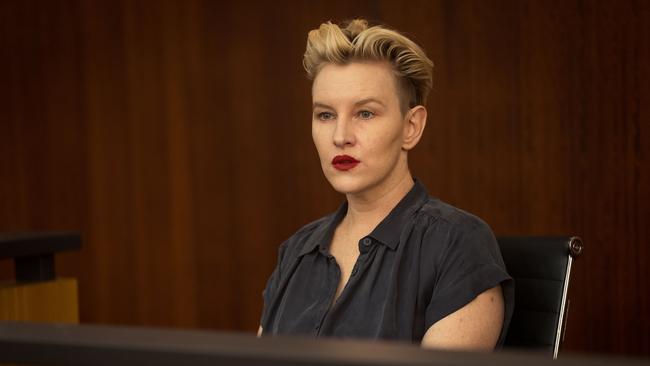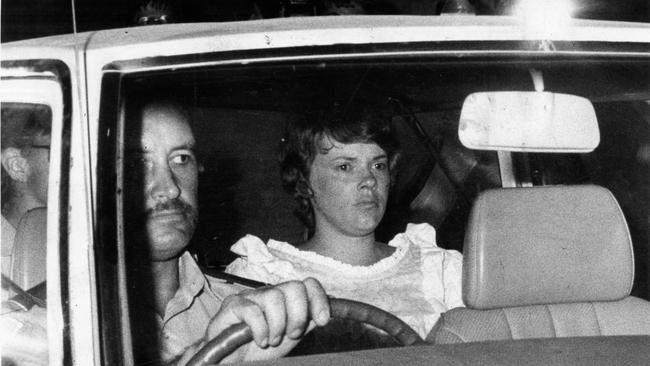‘Unhappy fluke’: courtroom drama The Twelve mirrors Depp-Heard case
Hot on the heels of the messy real-life legal spat, new courtroom drama The Twelve shows how jurors can’t help but be influenced. Star Kate Mulvany reveals how her appearance alone provoked bias.

It’s a busy time for Kate Mulvany, star of stage and screen and one of the country’s most prolific playwrights. She’s just flown from Melbourne, where she was shooting a Robbie Williams biopic, to Sydney, where she lives, for the premiere of another pop-star extravaganza, Baz Luhrmann’s Elvis (she plays Marion Keisker, the first person to record the King back in 1953).
She’s also in town to debut The Twelve, Foxtel’s new 10-part courtroom drama. Mulvany is one of several local names in the cast, playing an art photographer accused of murdering her 14-year-old niece. The timing has worked out well; she jokes that back-to-back red carpets mean she might be able to recycle frocks.
A state of perpetual motion is a normal one for the multi-hyphenate. Mulvany, 45, was born in Geraldton, Western Australia, moved to Perth as a teenager to study at Curtin University, then left for Sydney. In the years since, she has forged a career as an actor and writer working across theatre, film and television. She adapted Jasper Jones for Belvoir and The Harp in the South for Sydney Theatre Company, and was one of the writers on Upright, the television series starring Tim Minchin.
As an actor, she’s performed on main-stages all over the country, as well as in TV shows like such as RFDS and Hunters – the latter her first American series, in which she starred alongside Al Pacino as a Nazi-hunter in 1970s New York.
She was shooting the second season in Austria when she was offered The Twelve and began filming it only days after returning to Australia. Her work rate is even more shame-inducing when one considers that Mulvany suffers chronic pain – the result of radiation treatment for cancer when she was just a child.
A local adaptation of a Belgian series, The Twelve begins on the first day of a murder trial that many legal experts believe shouldn’t even be happening. There’s no body, so it’s possible the teenage girl at the centre of the case is simply missing. That’s certainly what Sam Neill, who plays Mulvany’s barrister, would have the jury believe. His counterpart on the prosecution is played by Marta Dusseldorp, no stranger to the legal drama, and the series was produced by former solicitor Ian Collie, best known for Rake. So all the little details feel authentic, from the boxed lunches and wooden cutlery in the jury room to the beta-blockers offered to nervous witnesses by their lawyers.

Mulvany speculates that she was cast because there’s a certain “theatricality” to her character, and “for a long time there, I guess, I was first and foremost known as a theatre person”. The sheer degree of theatricality is unclear to the audience, of course – we don’t know if the accused is lying. Mulvany had to keep the audience guessing while also playing a real human being, and those two demands could sometimes seem at odds. A whodunit usually relies on more than a few red herrings, after all, but Mulvany was careful to iron out any “discrepancies” with the team of writers, which includes her fellow playwrights Tommy Murphy and Anchuli Felicia King.
She kept things straight in her mind by creating a character map, something the actor does on every project. “So that I can keep track of exactly who says what about me when, and who knows what when. So that I can look at someone on set – even if that’s just someone that I never have any interaction with, except maybe in the courtroom – and know our history. The map is already there.”
She was given carte blanche to create the character’s look, and it’s a specific one. Short hair, dark-red lipstick. Mulvany wanted to create someone who might appear “arty and interesting” in her own, rather bohemian sphere, but also “a little bit confronting and scary” in the eyes of some jurors. She wanted to provoke certain biases: “If a woman has a shaved head, or if they wear no make-up but a really bold lipstick … I find that people get quite discombobulated by that. I don’t know why, there’s no reason for it. But that’s our culture.”
Throughout the shoot she was thinking about Lindy Chamberlain; about how women in the dock are expected to behave. As Neill tells his client, emotion is good, “histrionics” bad. Mulvany calls it an “unhappy fluke” that the show is premiering shortly after a defamation trial in which the demeanour of Johnny Depp’s former wife, Amber Heard, was dissected on a global scale – and frequently mocked. Mulvany didn’t watch any of those proceedings, she says. “I just couldn’t. I certainly got bombarded with the horrific Amber stuff on social media, and I could see what was happening, you know?”

The Twelve, as much as anything, is about perception, and the series follows the jury members home to discover that each has problems of their own – which in turn influence their responses to the case. Once they’re in the courtroom, “all their stories are rippling through the room together”, as Mulvany puts it, in one big feedback loop. As in the Depp-Heard case, The Twelve also shows how jurors can’t help but be influenced by media coverage and the tenor of online chatter, regardless of any court-mandated blackout.
Mulvany loved watching the other actors work. Seeing the likes of Brendan Cowell or the “brilliant” Nic Cassim (Mr Inbetween) do something as simple as react to witnesses was, she says, riveting, and long days capturing all the angles in the courtroom meant plenty of opportunity to do so.

Her husband, Hamish Michael (Crownies), is also in the cast, and he plays a nasty piece of work: a controlling spouse who punishes his partner by locking her in the bathroom overnight. Though they don’t share any scenes, Mulvany has plenty sitting across from Brooke Satchwell, who plays his wife, and was moved watching “the repercussions of their scenes flitter across her extraordinary face”.
Satchwell’s own very public experience with domestic abuse is impossible to forget while watching her performance, though Mulvany doesn’t reference it directly.
But she does make the point that the series, while fiction, is about experiences that real people really go through, and “that’s very important. Because I don’t want to get up there and just put on a TV show, you know? It’s important that we actually connect with our viewers. And hopefully make them see the real-life stuff in a more empathetic light.”
The Twelve is streaming on Foxtel.



To join the conversation, please log in. Don't have an account? Register
Join the conversation, you are commenting as Logout